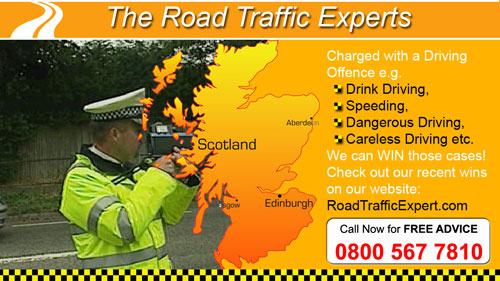ROAD SIGN OFFENCES
Road Sign Offences e.g. Running a Red Light

This offence covers a number of scenarios such as going through a red light, contravening double white lines, give way, no entry and one way signs.
Such offences are very regularly encountered but can have catastrophic consequences for the ill-advised driver who does not seek expert legal advice and later faces disqualification under the ‘ totting-up’ provisions (see separate subject heading).
In certain circumstances a driver who contravenes these sections in such a way that their driving falls below the standard that would be expected from a careful and competent driver may face prosecution for more serious offences such as careless and dangerous driving (see separate subject headings).
Yet again this area of law is inherently complex and those facing prosecution for such offences should seek expert legal advice at an early stage.
Failing to comply with road traffic signs is dealt with under section 36 of The Road Traffic Act 1988.
Such offences occupy a unique position in Scots Law insofar as they do not require to be ‘corroborated’ (the legal requirement whereby evidence must be led from two or more sources before a conviction can follow) and the evidence of one witness alone is sufficient for conviction.
We would strongly advise anyone stopped for a contravention of these rules to make ‘no comment’ to the police beyond divulging their name, address and date of birth. Rest assured that the Crown will not be slow to rely on the evidence of a ‘confession’ made by a driver at the time of an alleged offence in seeking a conviction.
Failing to comply with a road traffic sign will, on conviction, ordinarily result in the imposition of a fine of up to £1000. Where, however, the sign in question is a ‘Stop’ or ‘No entry’ sign then penalty points can also be imposed and a driver can even be disqualified from driving.
It should be borne in mind that prosecutions for contraventions of road traffic signs are technically complex and strict requirements, require to be met by the Crown before they can seek a conviction.
Any signs, wherever they are placed, must comply with the Traffic Signs Regulations and General Directions 2002 which set out precise requirements in relation to the size, colour and placing of road traffic signs. If the Crown fails to establish that these requirements have been met then a driver will have a defence to a charge under section 36.
By far the most common type of allegation of contravening traffic signals that we encounter is traffic light offences. Often these offences are detected by an automatic camera device positioned at a junction.
It is important to note that before evidence obtained from such a device can be used in a prosecution the police require to comply with strict procedural requirements. For example, the prosecution require to prove that the device was properly ‘calibrated’ (checked for accuracy).
One way for the prosecution to do this is to serve a notice upon a driver confirming that the device was calibrated prior to its use. If such a notice is not timeously challenged then it becomes impossible for the defence to challenge the machines accuracy at a later stage.
Where a traffic light offence is observed by a police officer then the legal requirements to be met by the prosecution are equally stringent. Police officers are not permitted to simply assume that a driver has ran a red light because the lights for vehicles traveling in the directly opposite direction are at red or the relevant pedestrian light is at green. In such circumstances evidence requires to be led by the prosecution that following upon the detection of the alleged offence the traffic lights were checked to see that they were operating in the correct sequence.
It is therefore vitally important that anyone charged with a ‘red light offence’ of this nature seeks advice from an expert road traffic lawyer as a matter of urgency.
Finally, it is important to note that further procedural requirements require to be met by the Crown before a driver can be prosecuted for a traffic sign offence. For example, the Crown must be able to show that they sent out a notice of intended prosecution (see separate subject heading) within fourteen days of the offence occurring or that a driver was properly notified by a police officer at the time of the offence .Moreover, a driver must receive a summary complaint citing them to appear at court within a period of six months from the date of the offence. If these requirements are not met then it unlikely that the case will be able to proceed against the driver.
- Running a Red Light and on 9pts. Police robustly examined, client acquitted!
- Bus Driver spotted by Police running a Red Light We find a technicality in evidence, client found Not Guilty!
- Client is a bus driver on 6 points facing 2 charges. Running a Red Light & Dangerous Driving. He faces a ban and losing his job. We battle both charges and he gets just 3 points!
- Captured on Police Video. Facing totting up ban. Client thought it was hopeless. We scrutinize the scene & get case dropped at trial diet after exposing technical defences.
- 2 Police officers claim to witness the offence, but we submit an argument on Jurisdiction and client is found Not Guilty!
- Prosecution presents 3 photos as evidence of client running a red light. We still get the dase dismissed!
- Client accused of running a red light and causing an accident. However, we show Fiscal that there is a strong weakness in their evidence and then persuade Fiscal to drop the case!
- Police claim witnessing client drive through red light. We find technical issues and convince Friscal to drop case!
- Taxi Driver faces ban and losing livelihood. 3 Police witnesses against our client. We delve into the details and find irregularities and persuade the Fiscal to discontinue case and therefore no need for trial!
- Taxi Driver charged with Careless Driving after Running a Red Light. We find issues with the evidence and Fiscal concedes. Client found Not Guilty!
- Client already on 9 points and if convicted faces losing his driving licence due to totting up the penalty points. Despite apparent very solid evidence from the prosecution, Richard Freeman finds a small legal technicality and uses it to win a Not Guilty Verdict. Client is delighted!
- Client accused of driving through 2 sets of red lights, witnessed by police. The police officer was not adequately prepared with his notebook and so we fervently argue an objection and client is found not guilty!
Click to see some court case examples of us defending alleged road sign infractions
We Cover All of Scotland

All of Scotland Covered:
Including: Glasgow Edinburgh Aberdeen Dundee Paisley Renfrewshire East Kilbride Perth Livingston Cumbernauld Hamilton
Kirkcaldy Dunfermline Ayr Kinross Kilmarnock Inverness Greenock Inverclyde Port Glasgow
Coatbridge North Lanarkshire Glenrothes fife Airdrie Falkirk Stirling Rutherglen Dumfries Galloway Motherwell Wishaw Clydebank West Dunbartonshire Bearsden East Dunbartonshire Cambuslang Newton Mearns East Renfrewshire Bishopbriggs Musselburgh East Lothian Arbroath Angus Polmont Elgin Renfrew Renfrewshire Alloa Bellshill Clackmannanshire Blantyre Dumbarton West Dunbartonshire Kirkintilloch Clarkston
East Renfrewshire Bathgate West Lothian Stenhousemuir Falkirk Peterhead Aberdeenshire Barrhead
Grangemouth Falkirk St Andrews Fife Kilwinning Ayrshire Giffnock viewpark Buckhaven Penicuik Midlothian Stranraer Johnstone Erskine Larkhall Moray


